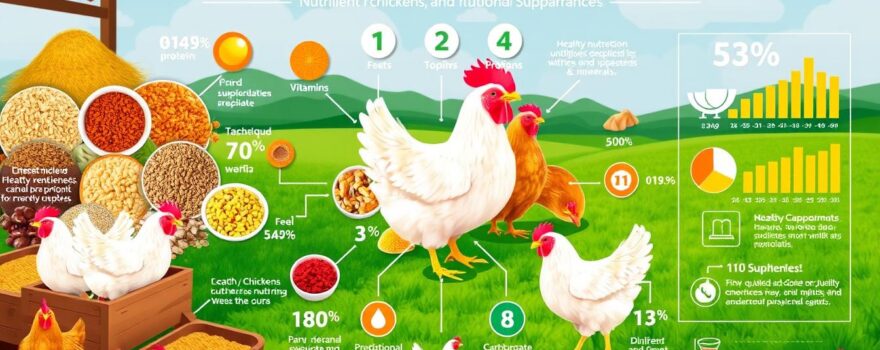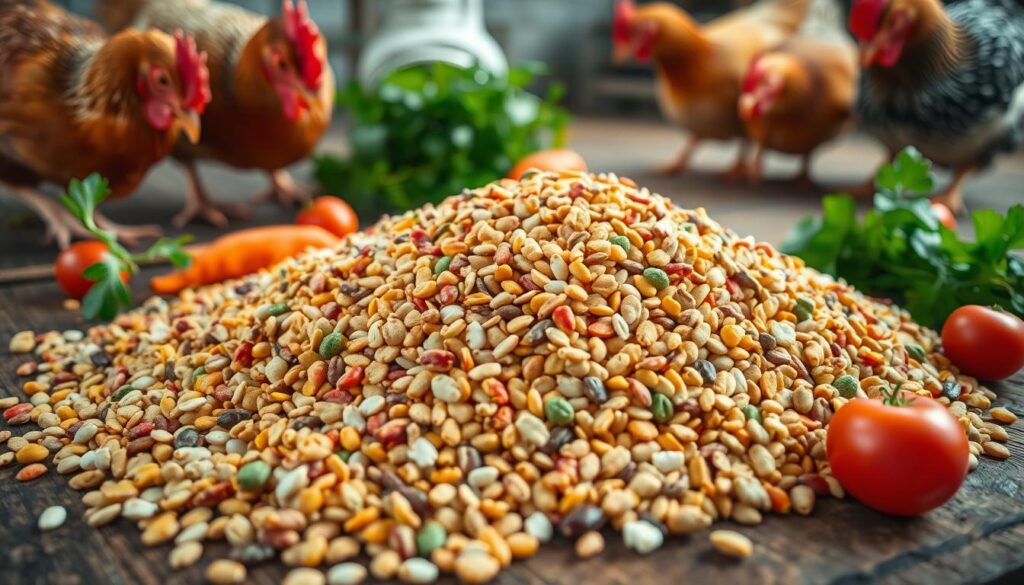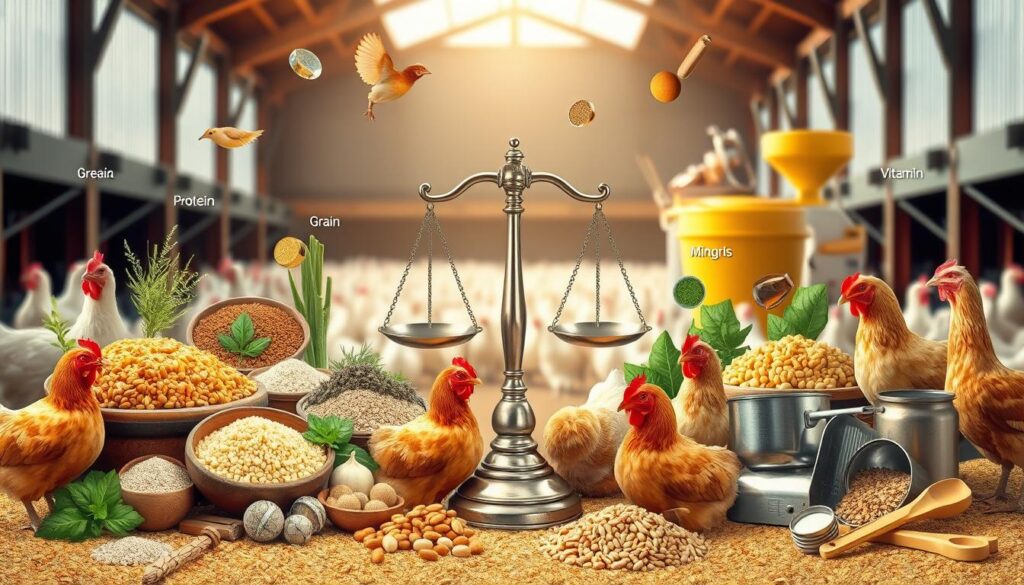
Creating the right feed for broiler chickens is key for their health and growth. This article explores the important parts of broiler nutrition requirements. We’ll look at the essential nutrients needed for a balanced and affordable diet.
We’ll cover the protein and amino acids they need. Also, how to ensure the right energy for their growth. You’ll learn how to make a detailed feed formulation plan.
Key Takeaways
- Broiler chickens have unique nutritional requirements for protein, amino acids, and energy levels to support their rapid growth and development.
- Selecting the right feed ingredients, such as corn, wheat, peas, oats, and fish meal, is crucial for creating a balanced and cost-effective broiler diet.
- Utilizing least-cost feed formulation strategies, including linear programming and ingredient substitution, can help optimize the feed’s nutritional value while minimizing expenses.
- Implementing a phase feeding approach with starter, grower, and finisher diets can further enhance broiler performance and productivity.
- Monitoring and adjusting broiler diets based on performance metrics, such as feed conversion ratio and nutrient density, is essential for ongoing optimization.
Understanding Broiler Nutrition Requirements
Raising healthy broiler chickens needs a good grasp of their nutritional needs. The key nutrients are protein and amino acids, and energy for growth. Finding the right mix is vital for their health and performance.
Protein and Amino Acid Needs
Protein is crucial for broiler growth. They need various amino acids for muscle building and repair. A balanced protein and amino acid profile in their diet boosts growth and efficiency.
Energy Requirements for Growth
Besides protein, broilers need specific energy for growth from their food. Energy from carbs and fats powers their activities and growth. The right energy balance in their feed is key for efficient growth.
Knowing the broiler nutrition requirements helps producers create better diets. This leads to better productivity, efficiency, and profits in raising broilers.
Essential Feed Ingredients for Broilers
Creating a balanced diet for broiler chickens is key for their growth and health. The feed ingredients are at the core of this. Each part, from proteins to energy sources, is vital for the bird’s well-being.
Protein is crucial for broiler chickens. Common sources include soybean meal, corn gluten meal, and animal-based proteins like poultry by-product meal and fish meal. These provide the amino acids needed for muscle growth and repair.
The energy sources in broiler feed are also vital. Corn, wheat, and sorghum are rich in carbohydrates. They fuel the birds’ daily activities and help them gain fat.
Vitamins and minerals are also key in a broiler’s diet. Vitamin A, D, E, and the B-complex vitamins boost immune function and bone health. Minerals like calcium, phosphorus, and trace minerals are essential for health and productivity.
Feed additives like enzymes, probiotics, and antioxidants also improve broiler diets. They enhance nutrient use, gut health, and overall well-being.
By choosing and mixing these feed ingredients for broilers carefully, producers can make a diet that supports growth and health. This ensures the best performance from their broiler flocks.
“Proper feed formulation is the foundation of successful broiler production.”
Least-Cost Feed Formulation Strategies
Creating broiler feed is a careful mix of nutrition and cost savings. The Least-Cost Feed Formulation strategy is key. It aims to find the best mix of ingredients for the lowest cost.
Linear Programming Approach
The Linear Programming Approach uses math to find the best feed mix. It looks at what the birds need, how much ingredients cost, and what’s available. This way, farmers can make sure their feed is good for the birds and doesn’t break the bank.
Ingredient Substitution Considerations
Being able to swap out ingredients is crucial in Ingredient Substitution Considerations. It lets farmers adjust to price changes and what’s in stock. But, they must make sure the new mix still meets the birds’ needs and doesn’t harm their health.
“Optimizing feed formulation is a critical component of broiler production, as it directly impacts both the profitability and the overall health and performance of the flock.”
How to Create a Balanced Feed Formulation for Broiler Chickens
Making a balanced feed for broiler chickens is key to their growth and health. It’s about knowing what nutrients they need, what ingredients to use, and how to keep costs down. This ensures they get the right mix of nutrients.
To make a balanced feed for broiler chickens, follow these steps:
- Find out what nutrients the chickens need: Look at protein, energy, vitamins, minerals, and more. These are important for their growth.
- Check out the feed ingredients: Look at the nutrients and prices of different ingredients. This helps you choose the best ones.
- Use cost-saving methods: Use math to find the cheapest mix of ingredients that still meets the chickens’ needs.
- Use phase feeding: Make different diets for different stages of the chickens’ lives. This helps them get the right nutrients at each stage.
- Make sure the feed is nutrient-dense: Balance the nutrients in the feed. This helps the chickens grow well and use feed efficiently.
By following these steps, you can make a feed that meets the chickens’ needs. This helps them grow well and use feed efficiently. It also makes your operation more profitable.
| Key Factors for Balanced Feed Formulation | Considerations |
|---|---|
| Nutrient Requirements | Protein, energy, vitamins, minerals, and other essential nutrients |
| Feed Ingredients | Grains, protein sources, supplements, and their nutrient profiles and costs |
| Formulation Strategies | Least-cost optimization, linear programming, and ingredient substitutions |
| Phase Feeding | Starter, grower, and finisher diets tailored to each stage of the broilers’ life cycle |
| Nutrient Density | Balanced amino acid profile and appropriate metabolizable energy levels |
By thinking about these factors, you can make a feed that helps your chickens grow and perform well. This makes your operation more efficient and profitable.
Phase Feeding for Broiler Performance Optimization
Modern poultry farming focuses on improving broiler performance. Phase feeding is a key strategy. It changes the diet’s nutrients as birds grow, meeting their needs at each stage.
Starter, Grower, and Finisher Diets
The starter diet helps young broilers grow fast, from 1 to 14 days old. It has more protein and energy to support their rapid growth.
When birds enter the grower phase, from 15 to 28 days, their diet changes. It’s lower in protein but higher in energy, fitting their changing needs.
The finisher diet is for the last growth stage, from 29 days to market weight. It’s designed to optimize growth and prepare birds for processing. This diet is lower in protein and higher in energy.
“By tailoring the nutrient composition of broiler diets to their specific growth stages, phase feeding allows for more precise nutrient delivery and can lead to enhanced performance and feed efficiency.”
Phase Feeding for Broilers is a common method in poultry farming. It uses Starter, Grower, and Finisher Diets to improve performance and feed efficiency. This approach helps producers get the most from their feed investment.
Nutrient Density in Broiler Diets
Keeping the right nutrient balance in broiler diets is key for their growth and health. The mix of protein, energy, vitamins, and minerals greatly affects their performance and well-being. This balance is crucial for broiler chickens.
Getting the nutrient balance right is a fine art. Protein and amino acids help build muscles and repair tissues. Carbohydrates and fats give them the energy they need to grow and stay active. Vitamins and minerals boost their immune system, bone health, and more.
Broiler producers must carefully plan their feed to meet the birds’ changing needs. Adjusting the nutrient mix as they grow helps improve feed efficiency and reduces waste. This approach also keeps the flock healthy.

Understanding the importance of nutrient density helps producers create better feeding plans. These plans support the birds’ growth and performance while reducing environmental impact. This knowledge is vital for sustainable and profitable broiler farming.
Improving Feed Conversion Ratio
Getting a good feed conversion ratio (FCR) is key in broiler farming. To do this, we need to focus on two main things. First, we must ensure the feed has a balanced amino acid profile. Second, we should aim to have the right amount of metabolizable energy in the diet.
Balanced Amino Acid Profile
Broiler chickens need the right mix of amino acids to grow well. A diet with the right balanced amino acid profile helps them use feed more efficiently. This means making sure they get enough lysine, methionine, and threonine in the right amounts.
Metabolizable Energy Levels
The metabolizable energy (ME) in the feed is also very important. Broilers need enough energy to grow and stay healthy. By adjusting the ME levels, we help them use nutrients better. This leads to better feed conversion and performance.
| Key Factor | Impact on FCR |
|---|---|
| Balanced Amino Acid Profile | Enhances feed efficiency and supports growth |
| Optimized Metabolizable Energy Levels | Improves nutrient utilization and overall broiler performance |
By paying attention to these two important areas of nutrition, producers can improve the feed conversion ratio. This makes broiler farming more profitable and sustainable.
Practical Considerations in Broiler Feed Formulation
Creating a balanced broiler feed is more than just mixing the right nutrients. It also involves thinking about the availability and handling of feed ingredients. Plus, how the environment affects what the birds need.
Choosing the right feed ingredients is key. Broiler producers need to find ingredients that are affordable and meet the birds’ needs. They might look for cheaper alternatives or use local materials.
How you store and handle the ingredients is also important. Keeping the feed in the right conditions helps prevent spoilage. This means controlling humidity and temperature.
The way you process the feed matters too. Things like particle size and whether it’s pelleted or extruded can change how well the birds can use the nutrients. It also affects how tasty the feed is to them.
Lastly, the environment around the birds can change what they need from their feed. Adjusting the feed based on temperature, humidity, and air quality can help the birds grow better.
| Practical Consideration | Importance |
|---|---|
| Ingredient Availability and Cost-effectiveness | Ensures that the feed formulation meets both the birds’ nutritional needs and the producer’s budget constraints. |
| Feed Ingredient Storage and Handling | Maintains the quality and integrity of the feed components, preventing spoilage or contamination. |
| Feed Processing Methods | Impacts the bioavailability of nutrients and the palatability of the feed, affecting broiler acceptance and performance. |
| Environmental Factors | Influences the broiler’s nutrient requirements, necessitating adjustments to the feed formulation. |
By considering these practical points, broiler producers can make feed that’s not just right for the birds. It also helps the birds grow well, use feed efficiently, and perform better overall.

Monitoring and Adjusting Broiler Diets
Keeping broilers healthy means always checking and changing their food. It’s important to watch how fast they grow, how much food they eat, and how well they use that food. This helps make sure they get the right nutrients for growing strong and healthy.
By keeping a close eye on these signs, farmers can spot any problems early. For example, if the birds aren’t growing as fast, they can tweak the food to help. Also, watching how much food they eat and how well they use it can help make the farm more efficient.
Being able to change the food is key. Broilers need different things at different times, depending on their age, where they live, and their health. By being quick to adjust, farmers can give their birds the best food for growing well and making the farm profitable.